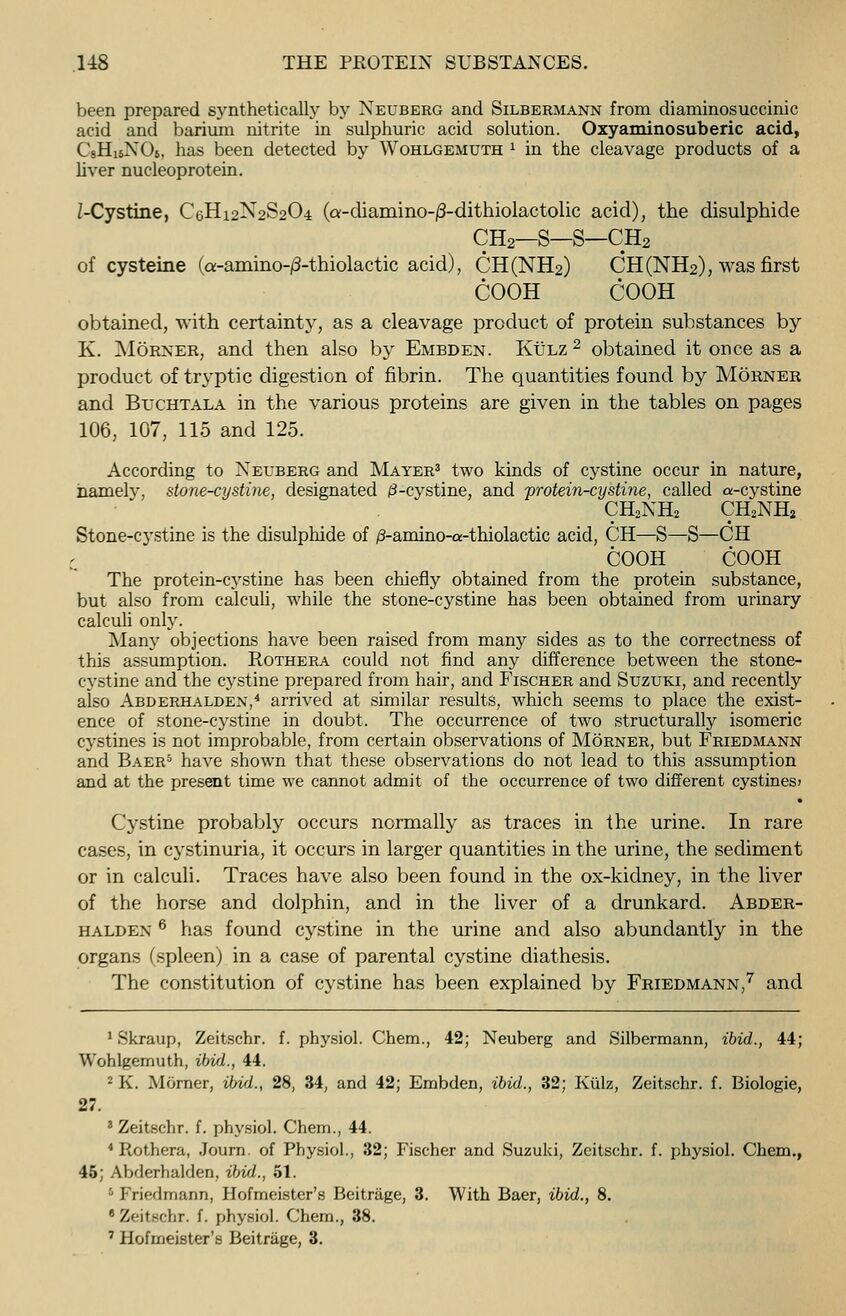
Full resolution (JPEG) - On this page / på denna sida - II. The Protein Substances - I. Simple Proteins - C. Cleavage Products of Simple Proteins - 3. The Amino-acids

<< prev. page << föreg. sida << >> nästa sida >> next page >>
Below is the raw OCR text
from the above scanned image.
Do you see an error? Proofread the page now!
Här nedan syns maskintolkade texten från faksimilbilden ovan.
Ser du något fel? Korrekturläs sidan nu!
This page has never been proofread. / Denna sida har aldrig korrekturlästs.
.148 THE PROTEIN SUBSTANCES.
been prepared synthetically by Neuberg and Silbermann from diaminosuccinic
acid and barium nitrite in sulphuric acid solution. Oxyaminosuberic acid,
C8 HisN06 , has been detected by Wohlgemuth l
in the cleavage products of a
liver nucleoprotein.
/-Cystine, C6H12N2S2O4 (a-cliamino-/3-dithiolactolic acid), the disulphide
CH2—S—S—CH2
of cysteine (a-amino-|3-thiolactic acid), CH(NH2 ) CH(NH2), was first
COOH COOH
obtained, with certainty, as a cleavage product of protein substances by
K. Morner, and then also by Embden. Kulz 2
obtained it once as a
product of tryptic digestion of fibrin. The quantities found by Morner
and Buchtala in the various proteins are given in the tables on pages
106, 107, 115 and 125.
According to Neuberg and Mayer3
two kinds of cystine occur in nature,
namely, stone-cystine, designated /3-cystine, and protein-cystine, called a-cystine
CH2 NH2 CH2 NH»
Stone-cystine is the disulphide of /3-amino-a-thiolactic acid, CH—S—S—CH
c
COOH COOH
The protein-cj’stine has been chiefly obtained from the protein substance,
but also from calculi, while the stone-cystine has been obtained from urinary
calculi only.
Many objections have been raised from many sides as to the correctness of
this assumption. Rothera could not find any difference between the stone-
cystine and the cystine prepared from hair, and Fischer and Suzuki, and recently
also Abderhalden,4
arrived at similar results, which seems to place the exist-
ence of stone-cystine in doubt. The occurrence of two structurally isomeric
cystines is not improbable, from certain observations of Morner, but Friedmann
and Baer5
have shown that these observations do not lead to this assumption
and at the present time we cannot admit of the occurrence of two different cystines;
Cystine probably occurs normally as traces in the urine. In rare
cases, in cystinuria, it occurs in larger quantities in the urine, the sediment
or in calculi. Traces have also been found in the ox-kidney, in the liver
of the horse and dolphin, and in the liver of a drunkard. Abder-
halden 6
has found cystine in the urine and also abundantly in the
organs (spleen) in a case of parental cystine diathesis.
The constitution of cystine has been explained by Friedmann,7 and
1
Skraup, Zeitschr. f. physiol. Chem., 42; Neuberg and Silbermann, ibid., 44;
Wohlgemuth, ibid., 44.
2
K. Morner, ibid., 28, 34, and 42; Embden, ibid., 32; Kulz, Zeitschr. f. Biologie,
27.
3
Zeitschr. f. physiol. Chem., 44.
4
Rothera, Journ. of Physiol., 32; Fischer and Suzuki, Zeitschr. f. physiol. Chem.,
45; Abderhalden, ibid., 51.
Friedmajon, Hofmeister’s Beitrage, 3. With Baer, ibid., 8.
• Zeitschr. f. physiol. Chem., 38.
7
Hofmeister’s Beitrage, 3.
<< prev. page << föreg. sida << >> nästa sida >> next page >>